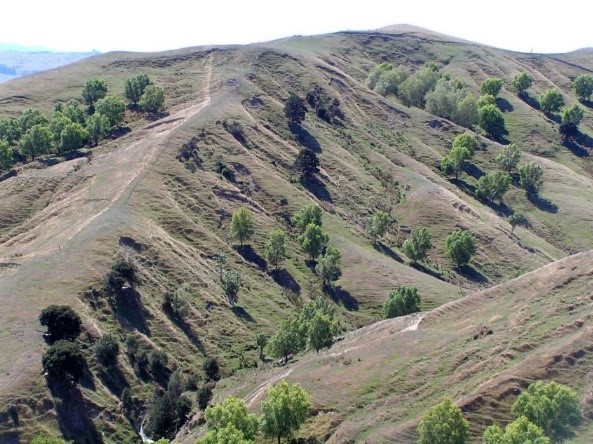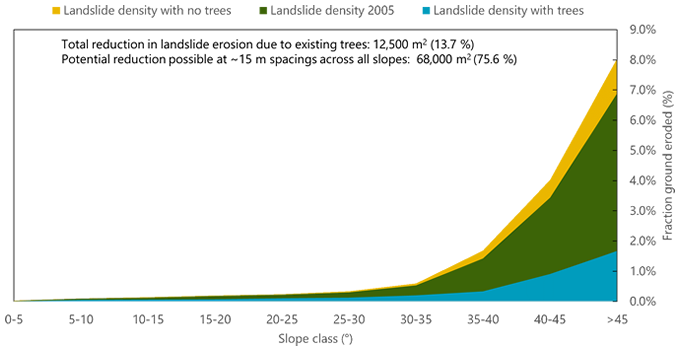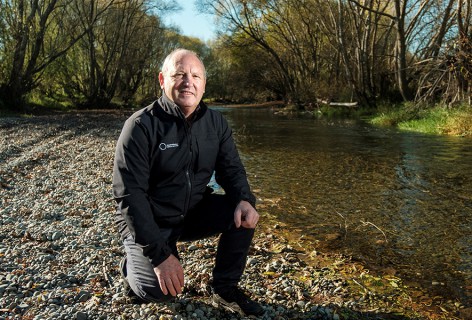- Home
- ...
- Smarter Targeting of Erosion Control (STEC)
- Smarter Targeting of Erosion Control (STEC) News
Improving understanding of the effectiveness of space-planted trees in reducing shallow landslide erosion
Previous studies have most often used one of two approaches for assessing the effectiveness of space-planted trees: 1) an empirical approach comparing the amount of ground eroded between treated (planted) and control sites (not planted) or 2) a physical, process-based approach using measures for root reinforcement to calculate the increase achieved in soil cohesion and slope stability. In this study, the former method is being used at landscape scale to assess how effective trees were at mitigating landslide erosion during a rainfall storm event in 2005 in a study area in the Wairarapa, located 10 km south-east of Masterton (Fig. 1). The area consists of four small sub-catchments draining into the Tauweru River, with a combined area of 900 ha.

Figure 1 Space-planted trees at Te Whanga Station, Wairarapa. (Photo provided by Les Basher.)
The effectiveness of 5,500 trees present in the landscape was assessed by considering the spatial relationship between the location of trees and landslide scars. For treated sites, results show a reduction of 60–80% in landslide erosion across different slope classes, calculated as the difference in eroded ground between treated and control sites. Figure 2 shows both the actual and potential reduction in landslide erosion across the study area. The actual reduction, calculated by considering only the existing trees within the study area, amounts to a reduction of 13.7%. The potential reduction is what would be expected with established poles located across the entire study area at an average spacing of 15 m, assuming the same reductions could be achieved as currently observed in the treated areas of the study area, which would amount to a reduction of 75.6%. The average reduction in eroded ground per tree was more than 7 m2/tree on slopes >40°, compared with 0.3 m2/tree on slopes 20–30°. This means that trees planted on steeper slopes are more than 20 times as effective at reducing landslide erosion than trees on moderate slopes (Fig. 2). This is because the rate of landsliding is greater on steeper slopes, and so trees located here have greater impact.

Figure 2: Fraction of ground eroded on different slope classes with and without influence of trees. The yellow area indicates predicted increase in ground eroded had no trees been present in the study area; The green area is the level of actual landslide erosion mapped; the blue area is the likely fraction of ground eroded with space planting across all slopes.
It is clearly the case that effectiveness of biological erosion control is a function of the spatial variation in:
- Additional soil reinforcement due to the presence of roots, i.e. the density and strength of roots generally decrease with distance from tree stem.
- Successful establishment of plantings; the mortality rate is likely to increase when exposed to unfavourable environmental conditions (e.g. shallow and more drought-prone soils on steeper slopes).
- Landslide erosion, i.e. the probability of landsliding can vary substantially across farms and paddocks.
Experience tells us that the successful establishment of poles on steeper slopes (>30°) is far more difficult, given survival rates in these areas are poor due to shallow soils. Deeper soils generally provide more water and nutrients to plants than shallow soils. Furthermore, there is evidence that certain species may not penetrate the underlying bedrock, such as massive mudstone. With only shallow lateral root systems and no basal root reinforcement, trees are prone to windthrow in areas with shallow soils.
The results from this assessment confirm findings from previous studies that trees can be effective at reducing landslide erosion when targeting susceptible slopes. However, this study demonstrates that there is a significant difference between the actual and potential reduction in landslide erosion at landscape scale, which raises some important questions: How well are current erosion control practices achieving reduction in rates of erosion? How can we better target the most erodible land? How do we define successful treatment of highly erodible land? How many more trees are needed to reduce landslide erosion to minimum?
If the primary objective of space-planted poles is a reduction in erosion and sediment runoff, then 50% of the trees located on slopes <30° are essentially ineffective in this study area, since very few landslides are triggered on moderate slopes (Fig. 2). Should a measure of effectiveness be equated with a measure of success – à la ‘the right tree, in the right place, for the right purpose’?
Your views
When planting poles, it is important to consider both 1) increasing slope stability and 2) successful establishment of poles. We are interested to hear what your experience has been in balancing these considerations in practice. Can both be achieved?
We invite you to complete a short survey using the following link: https://www.surveymonkey.com/r/QSRF3F9
